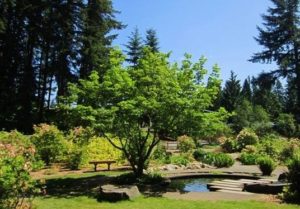Lake Wilderness Arboretum’s beautiful display gardens have been created, cultivated, transformed and maintained by dedicated volunteers for 50 years.
We have five unique gardens for visitors to enjoy, all with their own way of celebrating our love for the Northwest landscape.
Smith-Mossman Western Azalea Garden

Smith-Mossman Garden. View from the water feature.
Visitors can stroll through the bright, sunny signature garden on paths winding through one
of the largest collections of deciduous western azaleas (Rhododendron occidentale) in the
world. The plants started as cuttings, collected from 1966 to 1981 by Mr. Britt Smith and Dr.
Frank Mossman, for whom the garden is named. The azaleas are normally in peak bloom in
May and June, delighting the eye as well as the nose with a musky, sweet scent. Rounding
out the garden are cultivars of many of our native plants such as vine maples, flowering currants,
dogwoods, big leaf maples, and conifers. The garden is also home to many ants,
bats and owls.
Perennial Garden
The Perennial Garden is anchored by a thriving display of hardy fuchsias, gifted to the Arboretum by the Northwest Fuchsia Society and the Western Fuchsia Species Society. The garden also contains a wide variety of perennials and flowering shrubs that attract hummingbirds, putting on a lively show in mid-summer.
Legacy Garden
The Legacy garden preserves plants from two well-known Pacific Northwest gardeners, Loie Benedict and Marjorie Baird and highlights the love each of them had for the value of a plant that delights the senses. Throughout the seasons, look for interesting blooms, berries, leaf shapes and colors. Plants in this garden thrive in the temperate Northwest climate. The Legacy Garden is also home to the Lake Wilderness Arboretum’s Little Free Library.
Woodland Garden
The Woodland Garden has developed over time under the cover of our native Douglas firs and highlights plants that thrive in northwest woodlands. With a relaxed and natural feel this garden shows off a cultivated and natural beauty in every season.
Four collections of plants to look for:
Japanese Maples
These delicate and beautifully formed trees grow in different sizes, shapes and colors. The leaves of these deciduous trees range from lacy and finely divided to bold and beautiful, providing year-round interest in the Northwest garden.
Redwood Trees
Three species of trees are commonly referred to as redwoods: California’s coast redwood (Sequoia sempervirens), giant sequoia (Sequoiadendron giganteum), and China’s dawn redwood (Metasequoia glyptostroboides). All 3 types of redwoods are included in the Woodland Garden.
Hydrangeas
Mop tops to lace caps, dwarf to climbing, variegated to oak leaf hydrangeas are all brought together in a diverse sampling of this favorite bloomer, which makes a dazzling show of color in mid-summer to late fall.
Rhododendrons
Gifted in memory of his wife, Lillie, the Rhododendron Collection was grown and nurtured by George Stueber for 30 years and became the first garden display at the Arboretum. This area is at its peak in mid-spring with many different rhododendron varieties represented.
Rock Garden
The Alpine Garden features two distinct displays of plants that 1) grow well near or above the timberline and that 2) grow well in rocky, dry conditions.
